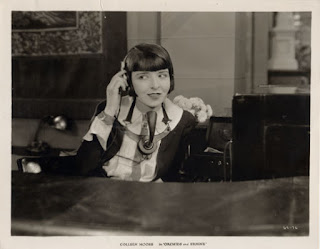Monsieur Linder, not just a master of slapstick but also subtext and, indeed, the comedy of cheese.
David Robinson introduced and gave a fascinating insight into the early years when film comedy had a French accent, albeit silent… From the Lumière brothers' naughty gardener standing on his colleagues hose in 1895 through to the manic André Deed aka Cretinetti or Foolshead, the French set the style culminating in Max Linder, perhaps among the first to develop more complex emotional resonance with his cinematic comedy?
Linder began making films in 1905 and by the time of the First World War, it wasn’t just Charlie Chaplin who described him as The Master. The war left a deep mental scar on Linder and he became deeply depressed in the years after it. Despite making a number of Hollywood films – including Seven Years… and the sublime, The Three Must-get Theres – he committed suicide in Paris along with his wife in 1925.
The Linder’s baby daughter Maude, was raised by her mother’s parents, who never mentioned her famous papa until, at the age of 18, she discovered his truth and started to preserve his legacy. David Robinson has met Maude on a number of occasions and she lives on now in her 90’s, proud of her father’s talent and achievements.
 |
| A cheesy grin from Max et sa belle-mère (1911) |
Elizabeth-Jane Baldry accompanied on harp proving again how flexible that instrument can be in this context: she played some lovely lines as you would expect but also hit the strings hard to create surprising atonal riffs. This instrument rocks and if Jimi ever played harp, well... it could have sounded a little like this.
The main feature was Seven Years Bad Luck, one of three films Linder made in Hollywood post-war and famous for its much-imitated mirror sequence.
 |
| Whersh my key...? |
But the real fun starts in the morning with his mirror as after his as Max's Valet John (Ralph McCullough) and Maid Mary (Betty Peterson) break his dressing mirror and coax his chef (Harry Mann) into pretending to be his master’s reflection. It’s the first time – I suppose – this act was done and it a mini-masterwork of invention: from Max’s deep concern at his handsome fizzog turned a little plain to his trouble with making his shaving foam stick.
Just as our hungover hero thinks he’s figured it out the servants get the mirror fixed and Max throws a shoe through it: seven years bad luck!
 |
| Max and Harry |
Max’s relationship with his fiancée Betty (Alta Allen) is a comically-fragile one – each as whimsical as the other; a perfect match – and he veers from winning her over to annoying her with the click of a phonograph and a silly Hawaiian dance with his other maid (Lola Gonzales). Betty throws him out on the grounds he has turned the house into a music hall.
Off goes Max leaving his pal (F. B. Crayne), who has designs of his own, to smooth things over with Betty… Max then decides to pack his bags and go on an adventure, because this is what you must do when relationships need work – perhaps he can escape?
 |
| Alta Allen with a girl's best friend? |
Max takes refuge in a zoo as a troop of cops pursues him. He tells a friendly lioness that he won’t eat her and generally pushes the Gallic whimso-meter onto full. He has his own style and sub-textural comedy quite distinct from Charlie, Buster and Roscoe. But then again he was first among these equals and there are extra bonus points for that!
 |
| Max's conflicted dream of happy ever after... |
Daan van den Hurk provided accompaniment and impressed with his controlled fluidity – every pianist has their own style and Daan was perfect for this tale of comedy heartbreak. I’m no musician but I would hazard a guess that the set up and punchline and sheer emotional unpredictability of comedy makes these films a challenge to accompany.
There’s also the ever-present danger of breaking into laughter. So, play along, match the tempo and never, ever laugh… tough gig! But a packed Arnolfini really appreciated the effort!
Seven Years Bad Luck is part of the Kino Max Linder Collection which is available direct or from Amazons... daft not to if you haven't already.






























%20Despair.png)







+colour.png)
